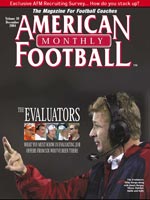AMERICAN FOOTBALL MONTHLY THE #1 RESOURCE FOR FOOTBALL COACHES
Article CategoriesAFM Magazine
|
No Huddle? More ChancesThe Lambuth Univeristy Eagles use the no-huddle offense to change the tempo at which they run plays. The result - more snaps per game.© More from this issue In 2002 the Lambuth University Eagles went 6-4 and averaged 55 snaps per game. During the spring of 2003 we put in the no-huddle offense. Our general offensive scheme did not change, just the tempo at which we ran the plays. In the 2003 season we increased our snaps per game to 70 and improved our overall record to 9-3, won a conference championship, and a trip to the playoffs. This is roughly a 27% increase in the number of chances to score. In the 2004 season we fully expect our average number of snaps to increase again. As a general rule, offenses are always looking for ways to gain an advantage over defenses. Methods have ranged from the use of ....The full article can only be seen by subscribers. Subscribe today!
|
|
|||||||
| HOME |
MAGAZINE |
SUBSCRIBE | ONLINE COLUMNISTS | COACHING VIDEOS |
Copyright 2025, AmericanFootballMonthly.com
All Rights Reserved





